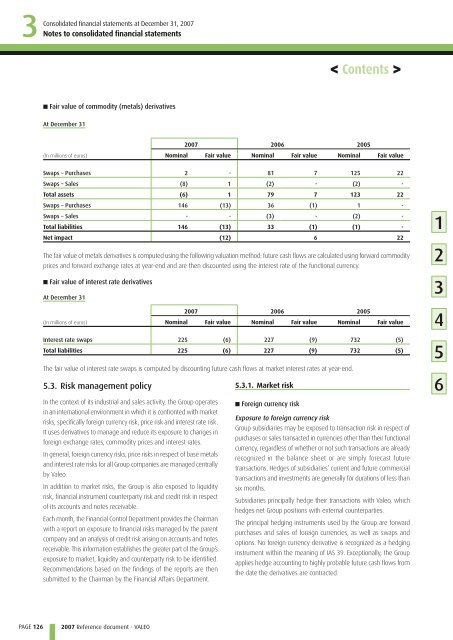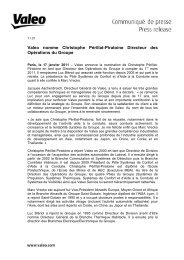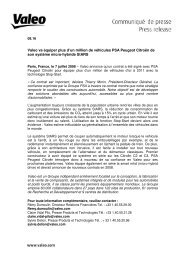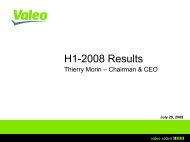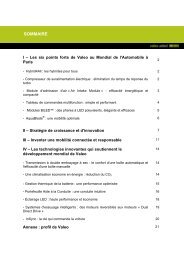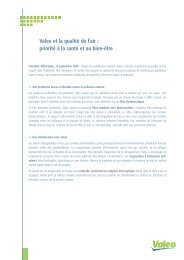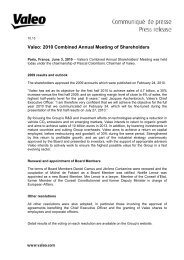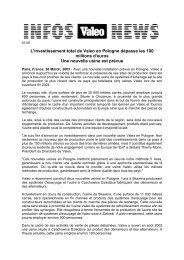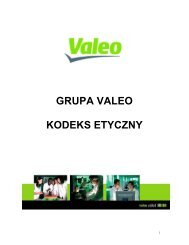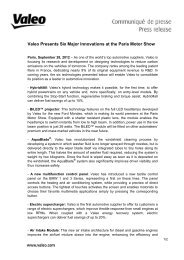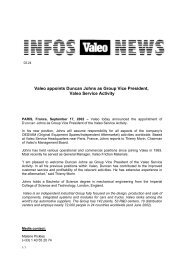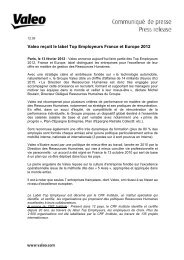2007 Reference document (PDF) - Valeo
2007 Reference document (PDF) - Valeo
2007 Reference document (PDF) - Valeo
You also want an ePaper? Increase the reach of your titles
YUMPU automatically turns print PDFs into web optimized ePapers that Google loves.
3 Consolidated<br />
PAGE 126<br />
fi nancial statements at December 31, <strong>2007</strong><br />
Notes to consolidated financial statements<br />
■ Fair value of c ommodity (metals) derivatives<br />
At December 31<br />
(In millions of euros)<br />
<strong>2007</strong> <strong>Reference</strong> <strong>document</strong> - VALEO<br />
<strong>2007</strong> 2006 2005<br />
Nominal Fair value Nominal Fair value Nominal Fair value<br />
Swaps – Purchases 2 - 81 7 125 22<br />
Swaps – Sales (8) 1 (2) - (2) -<br />
Total assets (6) 1 79 7 123 22<br />
Swaps – Purchases 146 (13) 36 (1) 1 -<br />
Swaps – Sales - - (3) - (2) -<br />
Total liabilities 146 (13) 33 (1) (1) -<br />
Net impact (12) 6 22<br />
The fair value of metals derivatives is computed using the following valuation method: future cash flows are calculated using forward commodity<br />
prices and forward exchange rates at year-end and are then discounted using the interest rate of the functional currency.<br />
■ Fair value of i nterest rate derivatives<br />
At December 31<br />
(In millions of euros)<br />
<strong>2007</strong> 2006 2005<br />
Nominal Fair value Nominal Fair value Nominal Fair value<br />
Interest rate swaps 225 (6) 227 (9) 732 (5)<br />
Total liabilities 225 (6) 227 (9) 732 (5)<br />
The fair value of interest rate swaps is computed by discounting future cash flows at market interest rates at year-end.<br />
5.3. Risk management policy<br />
In the context of its industrial and sales activity, the Group operates<br />
in an international environment in which it is confronted with market<br />
risks, specifically foreign currency risk, price risk and interest rate risk.<br />
It uses derivatives to manage and reduce its exposure to changes in<br />
foreign exchange rates, commodity prices and interest rates.<br />
In general, foreign currency risks, price risks in respect of base metals<br />
and interest rate risks for all Group companies are managed centrally<br />
by <strong>Valeo</strong>.<br />
In addition to market risks, the Group is also exposed to liquidity<br />
risk, financial instrument counterparty risk and credit risk in respect<br />
of its accounts and notes receivable.<br />
Each month, the Financial Control Department provides the Chairman<br />
with a report on exposure to financial risks managed by the parent<br />
company and an analysis of credit risk arising on accounts and notes<br />
receivable. This information establishes the greater part of the Group’s<br />
exposure to market, liquidity and counterparty risk to be identified.<br />
Recommendations based on the findings of the reports are then<br />
submitted to the Chairman by the Financial Affairs Department.<br />
5.3.1. Market risk<br />
■ Foreign currency risk<br />
< Contents ><br />
Exposure to foreign currency risk<br />
Group subsidiaries may be exposed to transaction risk in respect of<br />
purchases or sales transacted in currencies other than their functional<br />
currency, regardless of whether or not such transactions are already<br />
recognized in the balance sheet or are simply forecast future<br />
transactions. Hedges of subsidiaries’ current and future commercial<br />
transactions and investments are generally for durations of less than<br />
six months.<br />
Subsidiaries principally hedge their transactions with <strong>Valeo</strong>, which<br />
hedges net Group positions with external counterparties.<br />
The principal hedging instruments used by the Group are forward<br />
purchases and sales of foreign currencies, as well as swaps and<br />
options. No foreign currency derivative is recognized as a hedging<br />
instrument within the meaning of IAS 39. Exceptionally, the Group<br />
applies hedge accounting to highly probable future cash flows from<br />
the date the derivatives are contracted.<br />
1<br />
2<br />
3<br />
4<br />
5<br />
6


